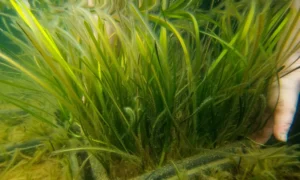Green green sea grass of home
{Green green sea grass of home – Earth and Leaf editorial}
{extract below}
Green green sea grass of home

Lets take a look at the unusual Welsh nursery growing sea grass to save marine habitat. Bottom trawling must also be banned in these habitats. Sea grass meadows absorb huge amounts of CO2.
It is a much-loved stretch of Celtic coastline, revered by poetry lovers as the place where Dylan Thomas lived his final years and by thrill seekers as a spot for breaking land-speed records.
Now between Thomas’s boathouse home at Laugharne and the natural fast track of Pendine Sands in south-west Wales, an ambitious project is under way to try to help restore one of the world’s most important and threatened habitats: seagrass meadows.
Two species of seagrass, flowering plants that live in shallow, sheltered bays and provide a vital habitat for species including seahorses, octopuses and cuttlefish and are an important carbon sink, are being grown in ponds fed with seawater pumped in from Carmarthen Bay.
Over the past two years, what is being billed as the UK’s first large-scale seagrass nursery has processed 1.5m seeds collected from sites in Wales and England and grown tens of thousands of plants, the first of which have been introduced into the wild to restore underwater meadows.